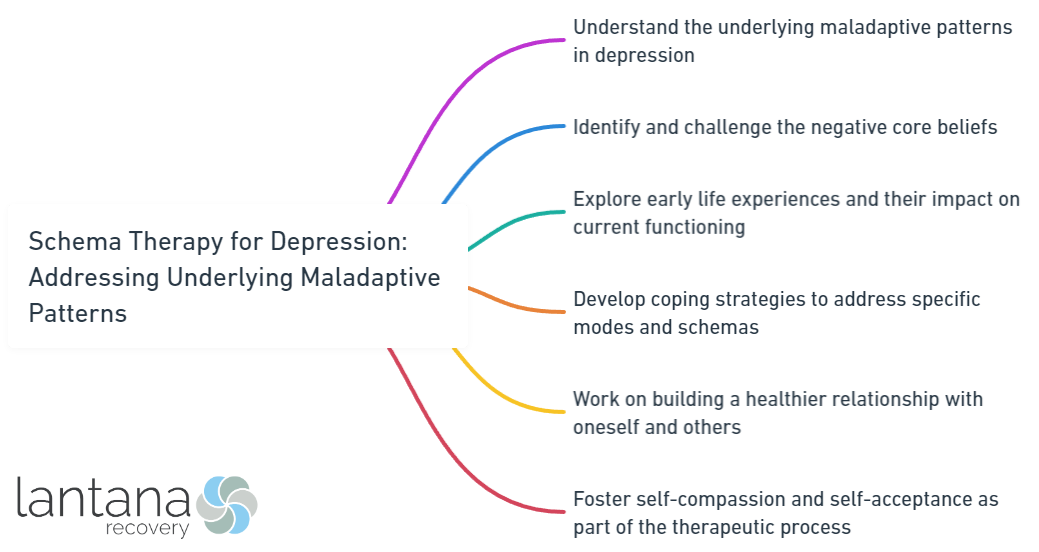Schema Therapy, also known as Schema-Focused Cognitive Therapy, is an evidence-based approach that is gaining recognition as an effective treatment for depression. It targets underlying maladaptive patterns or schemas that contribute to depressive symptoms and aims to bring about lasting change.
Schema Therapy addresses these maladaptive patterns by understanding their origins, identifying unmet emotional needs, and challenging and modifying them. By doing so, individuals can gain improved understanding of themselves, develop enhanced coping skills, and experience long-term relief from depressive symptoms.
This therapy is particularly beneficial for individuals with chronic or treatment-resistant depression, those with a history of childhood trauma, and individuals with co-occurring personality disorders. Finding a qualified schema therapist, completing assessments, setting goals, and developing a treatment plan are important steps to start schema therapy for depression.
While schema therapy has shown promising results, there may be challenges such as the time commitment and intensity of therapy, resistance to change, and availability of trained schema therapists. However, real-life case studies highlight the potential effectiveness of schema therapy in treating depression.

What is Schema Therapy?
What exactly is Schema Therapy? Dive into this fascinating topic as we uncover the basics and key concepts behind this therapeutic approach. Gain insights into the underlying maladaptive patterns that Schema Therapy aims to address. Discover how this approach can offer individuals a unique perspective and strategies to navigate through their struggles with depression. So, let’s delve into the world of Schema Therapy and get ready to unlock a path towards healing and growth.
Understanding the Basics of Schema Therapy
In order to comprehend the fundamentals of schema therapy, it is crucial to familiarize oneself with the key points about this form of psychotherapy. Schema therapy was developed by Dr. Jeffrey E. Young in the 1980s and is an amalgamation of cognitive-behavioral therapy, psychodynamic therapy, and gestalt therapy.
The primary objective of schema therapy is to identify and modify deeply ingrained patterns or maladaptive schemas. These schemas are formed during childhood and are influenced by early experiences and interactions. It is these maladaptive schemas that give rise to negative self-beliefs, emotional difficulties, and problematic relationship patterns.
The focal point of schema therapy is to address the unmet emotional needs from early life. Through the course of therapy, individuals actively learn how to challenge and subsequently modify these maladaptive patterns, while also developing healthier coping strategies.
It is important to recognize that schema therapy is a longer-term treatment approach, typically spanning from 6 months to 2 years. The effectiveness of schema therapy has been observed in individuals struggling with chronic or treatment-resistant depression, as well as those who have experienced childhood trauma or possess co-occurring personality disorders.
Understanding the basics of schema therapy empowers individuals to address maladaptive patterns and attain long-term relief from depressive symptoms. By acquiring a holistic understanding of the fundamentals of schema therapy, individuals are equipped to make informed decisions regarding their mental health treatment. This comprehension also enhances their understanding of the therapeutic process and goals, providing a clearer path towards improved mental well-being.
Key Concepts in Schema Therapy
Schema therapy is an approach that focuses on identifying and modifying maladaptive schemas, which are deeply ingrained negative patterns of thoughts, feelings, and behaviors. This therapy encompasses key concepts such as schemas, emotional needs, modes, coping strategies, and reparenting.
Schemas, which are core beliefs or thinking patterns that develop in early life, shape how we perceive ourselves, others, and the world. When these schemas are maladaptive, they contribute to emotional distress and dysfunctional behavior.
Addressing unmet emotional needs is crucial in schema therapy as these needs, including safety, love, validation, autonomy, and structure, play a significant role in the development of maladaptive schemas.
Modes are transient emotional states that reflect the activation of certain schemas and coping strategies. Understanding these modes helps individuals gain insight into their emotional experience and learn healthier coping strategies.
Identifying maladaptive coping strategies, such as avoidance, overcompensation, or surrendering, is an important focus in schema therapy. By challenging these strategies and developing more adaptive ones, individuals can enhance their emotional well-being.
Reparenting involves nurturing and providing supportive experiences for the inner child. Through visualization and role-playing exercises, individuals cultivate a compassionate and caring relationship with themselves.
True Story: John struggled with low self-esteem and a fear of rejection. Through therapy, he discovered his maladaptive schema of “unlovability” and recognized its impact on his relationships and career. By challenging this belief and developing self-compassion, John gradually improved his self-image, interpersonal skills, and overall fulfillment in his personal and professional life.
Schema therapy relies on key concepts such as schemas, emotional needs, modes, coping strategies, and reparenting to address maladaptive patterns. By understanding and working with these concepts, individuals can achieve long-lasting relief from depressive symptoms and develop a healthier sense of self.

How Does Schema Therapy Work for Depression?
Looking into the intricacies of how schema therapy works for depression – we will uncover the underlying maladaptive patterns, address the emotional needs tied to them, and challenge and modify these patterns to pave the way towards emotional healing and well-being. By delving into these sub-sections, we will unveil the transformative power of schema therapy in reshaping one’s internal narrative and fostering lasting change. Let’s embark on a journey of self-discovery and liberation from the chains of maladaptive thinking.
Identifying Maladaptive Schemas
Identifying maladaptive schemas is essential in the practice of schema therapy for depression. These schemas are deeply ingrained patterns of beliefs and feelings that form during childhood and continue to influence thoughts, behaviors, and emotions in adulthood. It is crucial to consider the following key points when identifying maladaptive schemas:
- Emotional triggers: Maladaptive schemas emerge in response to specific triggers or situations that elicit intense negative emotions. By paying attention to recurring emotional reactions, individuals can recognize underlying schemas that contribute to their depressive symptoms. Take note, this differs from emotion-focused therapy for depression.
- Negative core beliefs: Maladaptive schemas are rooted in negative beliefs about oneself, others, and the world. These beliefs often consist of self-critical, perfectionistic, or pessimistic thoughts. Identifying these negative core beliefs helps individuals understand the underlying thought patterns that contribute to their depression.
- Early life experiences: Maladaptive schemas typically originate from childhood trauma, neglect, or dysfunctional family dynamics. Exploring past experiences provides insights into the origins of maladaptive schemas.
- Cognitive distortions: Maladaptive schemas are reinforced by irrational and unhelpful thinking patterns known as cognitive distortions. Common distortions include black-and-white thinking, catastrophizing, and overgeneralizing. Recognizing these distortions aids in the identification of maladaptive schemas.
- Patterns in interpersonal relationships: Maladaptive schemas often manifest as repetitive patterns of thoughts, emotions, and behaviors in relationships. These patterns can involve difficulties with trust, intimacy, and maintaining healthy boundaries. Identifying these patterns sheds light on underlying maladaptive schemas.
By identifying maladaptive schemas, individuals can develop a deeper understanding of their core beliefs and patterns that contribute to their depression. This understanding serves as the foundation for addressing and modifying these schemas through schema therapy, which ultimately leads to improved emotional well-being and relief from symptoms.
To facilitate the process of identifying maladaptive schemas, it is advisable to seek the guidance of a qualified schema therapist who can provide expertise and support throughout the therapy journey.
Addressing Underlying Emotional Needs
Addressing underlying emotional needs is essential in schema therapy for depression. This approach recognizes that maladaptive patterns in thinking and behavior often originate from unmet emotional needs in early life experiences. By acknowledging and validating these emotions, individuals can gain a better understanding of their emotions and develop healthier coping strategies.
In schema therapy, therapists collaborate with clients to identify and explore the underlying emotional needs that contribute to their depressive symptoms. This involves creating a safe environment where clients can comfortably express their emotions. By acknowledging and validating these emotions, individuals can develop a more compassionate and accepting relationship with themselves.
Once emotional needs are identified, the therapist assists clients in understanding how these needs influence their thoughts, behaviors, and relationships. Through techniques like imagery and role-playing, the therapist helps individuals process and challenge their maladaptive patterns. This process allows them to develop new strategies for meeting their emotional needs.
A true story that demonstrates the importance of addressing underlying emotional needs in schema therapy involves Sarah, a woman who battled depression for years. Sarah discovered that her emotional needs for connection and validation were not adequately met during her childhood. By addressing these needs in therapy, Sarah was able to cultivate healthier relationships and find fulfillment in life.
Addressing underlying emotional needs empowers individuals to overcome depression through schema therapy. It enables them to nurture emotional well-being and develop adaptive ways of meeting their emotional needs.
Challenging and Modifying Maladaptive Patterns
Challenging and modifying maladaptive patterns is a critical aspect of schema therapy for depression. In this therapeutic approach, individuals actively work to identify and change negative beliefs and behaviors that contribute to their depressive symptoms.
Through collaboration with a trained schema therapist, individuals are encouraged to challenge maladaptive patterns and replace them with healthier ways of thinking and behaving. This process involves several steps:
1. Identification: The first step is to identify the maladaptive patterns that contribute to depression. This includes negative beliefs about oneself, others, and the world, as well as self-defeating behaviors.
2. Exploration of origins: The therapist helps individuals explore the origins of these maladaptive patterns. This often involves looking into past experiences, especially those from childhood, that shaped these beliefs and behaviors.
3. Challenging beliefs: With the guidance of the therapist, individuals learn to challenge their negative beliefs and assumptions. They are encouraged to search for contradictory evidence and alternative perspectives.
4. Behavioral experiments: Engaging in behavioral experiments is an important part of the therapy. Individuals are encouraged to take risks and try new behaviors to test the validity of their maladaptive patterns. This helps them assess if these new behaviors lead to positive outcomes.
5. Cognitive restructuring: Another crucial aspect of the therapy is cognitive restructuring. Individuals learn to replace negative thoughts and beliefs with more balanced and realistic ones. This process helps them develop a positive and constructive outlook.
By actively challenging and modifying maladaptive patterns, individuals can develop new ways of thinking and behaving that enhance their mental well-being and reduce depressive symptoms. Schema therapy offers a structured approach to address underlying issues contributing to depression and create lasting positive change.
Benefits of Schema Therapy for Depression
Discover the incredible benefits that Schema Therapy for Depression can bring to your life. Gain an enhanced understanding of yourself, develop powerful coping skills, and experience long-term relief from depressive symptoms. This therapy approach goes beyond surface-level treatment, diving deep into the underlying maladaptive patterns that contribute to depression. Say goodbye to temporary fixes and embrace a holistic approach that can truly transform your well-being.
Improved Understanding of Self
Schema therapy for depression enhances the understanding of oneself, providing individuals with improved insight into deep-seated patterns of thought and perception, referred to as maladaptive schemas. By uncovering and addressing these schemas, individuals gain a better understanding of their negative thinking and self-criticism.
In addition, schema therapy acknowledges and validates emotional needs, allowing individuals to explore their underlying experiences. This process enables them to recognize and process their emotions within a supportive therapeutic environment, ultimately leading to a deeper understanding of their triggers and needs.
Moreover, schema therapy challenges and modifies maladaptive patterns, empowering individuals to develop more adaptive coping strategies. By examining the ways their thoughts, feelings, and behaviors contribute to depression, individuals can discover more effective ways to manage their symptoms.
Enhanced Coping Skills
Enhanced coping skills play a vital role in schema therapy for depression. This therapeutic approach assists individuals in developing new strategies to effectively manage the challenges and stressors they face on a daily basis.
- One crucial aspect of schema therapy is increasing self-awareness. By delving into emotional patterns and triggers, individuals gain a deeper understanding of themselves. This heightened awareness empowers them to recognize distress and explore healthier ways to cope.
- Emotion regulation is another key component of schema therapy. It equips individuals with the skills to effectively regulate and manage their emotions. By utilizing healthy coping mechanisms such as relaxation techniques and mindfulness exercises, individuals are able to prevent negative emotions from escalating.
- Schema therapy also focuses on enhancing problem-solving skills. Individuals learn how to tackle difficulties and conflicts by identifying underlying schemas that contribute to their challenges. They are then guided in finding practical and effective solutions.
- Schema therapy aids in building resilience. It helps individuals bounce back from setbacks and adversity. With enhanced coping skills, individuals can recover faster from depressive episodes and maintain a positive outlook on life.
- Interpersonal skills are improved through schema therapy. This therapy enhances communication and helps individuals foster healthy relationships. Consequently, individuals are better equipped to express their emotions, set boundaries, and navigate social situations, further enhancing their coping skills.
It is important to note that the effectiveness of enhancing coping skills through schema therapy may vary for each individual. Therefore, it is highly recommended to consult a qualified schema therapist who can tailor the therapy to meet specific needs and goals.
Incorporating enhanced coping skills into one’s life significantly contributes to managing and overcoming depression. It is important to understand that developing these skills takes time and consistent effort. However, the long-term benefits include improved well-being and a greater sense of control over one’s life.
Long-term Relief from Depressive Symptoms
Long-term relief from depressive symptoms is a crucial advantage of schema therapy for depression. Unlike other therapeutic approaches that only offer short-term relief, schema therapy focuses on addressing underlying maladaptive patterns that contribute to depression, leading to sustained improvements in overall well-being.
Through schema therapy, individuals develop an understanding of their core beliefs and thinking patterns that perpetuate their depressive symptoms. By actively challenging and replacing these maladaptive schemas, individuals can cultivate healthier thoughts and behaviors.
In addition, schema therapy also addresses the emotional needs that contribute to depression. By fostering emotional awareness and teaching effective coping skills, individuals can effectively manage their emotions and experience a long-term reduction in depressive symptoms.
True Story: Sarah’s story serves as a testament to the lasting relief from depressive symptoms achieved through schema therapy. Despite struggling with chronic depression, Sarah learned to challenge her negative beliefs and thinking patterns. Consequently, she developed healthy coping strategies and fostered a positive self-image. As a result, Sarah experienced a significant and sustained decrease in her depressive symptoms, ultimately finding joy and fulfillment in her life.

Who Can Benefit from Schema Therapy for Depression?
Are you struggling with chronic or treatment-resistant depression? Have you experienced childhood trauma that lingers in your thoughts and emotions? Perhaps you’re grappling with co-occurring personality disorders. If these situations resonate with you, then this section will shed light on how schema therapy for depression can be of immense benefit. No matter your unique circumstances, understanding who can benefit from this therapeutic approach is the first step toward addressing underlying maladaptive patterns and finding lasting relief.
Individuals with Chronic or Treatment-Resistant Depression
How does therapy help in the treatment of depression? Individuals with chronic or treatment-resistant depression face unique challenges that can make their condition even more difficult to treat. Schema therapy, a comprehensive approach, is specifically designed to address and modify maladaptive patterns of thinking and behavior that contribute to depressive symptoms. This therapy goes beyond simply managing symptoms and aims to tackle the underlying causes of depression. In doing so, individuals gain a deeper understanding of themselves, their emotions, and their needs, which ultimately leads to the development of more effective coping strategies. What sets schema therapy apart is its ability to provide long-term relief by helping individuals challenge and transform these maladaptive patterns, resulting in improved overall well-being.
Although schema therapy may not be suitable for every individual with depression, it has been shown to be particularly effective for those with chronic or treatment-resistant depression who have not found relief through other treatments. Therefore, incorporating schema therapy into treatment plans can offer a fresh perspective and renewed hope for individuals struggling with chronic or treatment-resistant depression.
People with a History of Childhood Trauma
People with a history of childhood trauma can benefit from schema therapy for depression. Schema therapy helps individuals identify and address maladaptive schemas developed from childhood trauma. The first step in schema therapy is identifying these negative beliefs about oneself and the world. For individuals who have experienced childhood trauma, these often include beliefs of being unworthy, unsafe, or unlovable.
Once these maladaptive schemas are identified, schema therapy focuses on addressing emotional needs. This involves cultivating a compassionate and nurturing therapeutic relationship to provide a safe space for individuals to heal. Challenging and modifying maladaptive patterns is another crucial aspect of schema therapy. Techniques such as cognitive restructuring and imagery rescripting help individuals challenge and change their negative beliefs and behaviors.
Schema therapy brings various benefits for people with a history of childhood trauma. It improves self-understanding and helps individuals recognize the impact of trauma on their thoughts, feelings, and behaviors. Additionally, it enhances coping skills and equips individuals with healthier ways to deal with distress and triggers. Schema therapy also offers long-term relief from depressive symptoms by addressing the root causes of depression stemming from childhood trauma.
It’s important to note that qualified schema therapists with experience in trauma-related issues should conduct schema therapy for individuals with a history of childhood trauma. The availability of trained schema therapists may vary, but seeking out a qualified therapist is crucial for the therapy’s success.
Individuals with Co-Occurring Personality Disorders
Individuals with co-occurring personality disorders can benefit from schema therapy for depression and co-occurring personality disorders. Schema therapy is an evidence-based approach that addresses the maladaptive patterns contributing to depression and personality disorders. It helps individuals with co-occurring personality disorders increase self-awareness, and understand their patterns of thinking, feeling, and behaving. Through this awareness, they can challenge negative schemas perpetuating depressive symptoms.
Additionally, schema therapy equips individuals with effective coping skills to manage depressive symptoms and maladaptive patterns, improving emotional well-being. By targeting core beliefs and underlying emotions linked to personality disorders and depression, schema therapy provides long-term relief from depressive symptoms. It promotes positive changes in thoughts, behaviors, and emotions, reducing depressive episodes. However, it is important to note that schema therapy for individuals with co-occurring personality disorders may require longer and more intensive treatment compared to those without personality disorders. Therefore, finding a qualified schema therapist trained in addressing personality disorders is crucial for effective treatment.
By addressing maladaptive patterns and providing tools to navigate emotions and thoughts, schema therapy offers hope and a path toward recovery from depression for individuals with co-occurring personality disorders.

How to Start Schema Therapy for Depression?
If you’re ready to embark on your journey with schema therapy for depression and address those underlying maladaptive patterns, let’s start by exploring how to begin this transformative process. We’ll dive into finding a qualified schema therapist who can guide you towards healing. We’ll also touch upon the essential steps of assessment and formulation, as well as setting goals and developing a personalized treatment plan. Get ready to take charge of your mental well-being and unlock a brighter future!
Finding a Qualified Schema Therapist
Finding a qualified schema therapist is crucial for effective therapy for depression. When seeking a qualified therapist, there are several factors to consider.
- Credentials and Training are important – look for a therapist with specialized training in schema therapy. They should have the necessary qualifications and certifications in psychotherapy.
- Additionally, experience is key. Consider therapists who have successfully utilized schema therapy techniques with clients dealing with depression.
- It is also important to ensure that the therapist has expertise in Schema Therapy. They should have a strong understanding of schema therapy principles and techniques, and be able to apply them effectively in treating depression.
- Seeking positive reviews and referrals from trusted sources is another important step. Recommendations from those who have had positive experiences with a therapist can provide valuable insight.
- Personal connection is essential. It is important to have a good rapport and trust with your therapist in order to create a safe and supportive environment for effective therapy.
- Accessibility is also a factor to consider. Think about the therapist’s location and availability for convenient access to therapy sessions.
When looking for a qualified schema therapist, it is important to research and compare different professionals. Find someone who understands your specific needs and has the expertise to guide you in addressing underlying maladaptive patterns. Keep in mind that finding the right may take time and effort, but it is crucial for your journey towards healing and well-being.
Assessment and Formulation
Assessment and formulation play a crucial role in schema therapy for depression. These two elements involve the thorough evaluation of an individual’s maladaptive schemas and the development of a customized treatment plan.
A comprehensive assessment is conducted by a qualified schema therapist to identify the core maladaptive schemas and emotional needs that contribute to the person’s depressive symptoms. This evaluation involves exploring past experiences, childhood memories, and current thought patterns.
Based on the findings of the assessment, the therapist formulates a treatment plan that specifically targets the identified maladaptive patterns and schemas. This plan includes the identification of triggers, coping mechanisms, and resilience factors. The formulation guides the selection of therapy techniques and interventions.
The assessment and formulation process follows a collaborative approach, actively involving the individual. They are encouraged to provide insights, feedback, and confirm the therapist’s understanding. This ensures that the treatment plan aligns with the individual’s goals and promotes a sense of empowerment.
Assessment and formulation are not one-time activities but are continuously adapted throughout the therapy process. The therapist regularly reassesses and refines the treatment plan based on the progress and insights gained. This flexibility allows for adjustments to address any barriers or challenges that may arise during the course of therapy.
By incorporating assessment and formulation, the foundation for effective schema therapy for depression is established. This comprehensive understanding of the individual’s struggles allows for targeted interventions and a personalized treatment plan. Through a collaborative approach and the ability to adapt as needed, therapists can provide effective support and guide individuals toward improved well-being.
When considering schema therapy for depression, it is crucial to find a qualified schema therapist who prioritizes assessment and formulation. These essential processes ensure a successful therapeutic journey and can bring about transformative change and long-term relief from depressive symptoms.
Setting Goals and Developing a Treatment Plan
Setting goals and developing a treatment plan are essential components of schema therapy for depression. These steps serve as a guide throughout therapy sessions and ensure progress toward desired outcomes.
- Evaluate the current situation: The first step is to assess the client’s mental and emotional state by understanding their symptoms, identifying any maladaptive schemas, and determining how these schemas impact their daily life.
- Collaboratively set goals: Next, the therapist and client work together to establish clear and specific goals that are based on the client’s unique needs and aspirations. Examples of these goals may include reducing depressive symptoms, improving self-esteem, and developing healthier coping strategies.
- Develop a treatment plan: After setting the goals, a comprehensive plan is created. This plan outlines specific interventions, techniques, and strategies that will be utilized to address the maladaptive schemas and ultimately achieve the established goals. The treatment plan may include individual therapy sessions, group therapy, homework assignments, and experiential exercises.
- Monitor progress: It is important to regularly track the client’s progress toward their goals. This involves evaluating their symptoms, assessing the effectiveness of the interventions being used, and making any necessary adjustments to the treatment plan.
- Review and revise goals: Periodically, the goals should be reviewed and revised to ensure that they align with the client’s changing needs and priorities.
By actively pursuing the process of setting goals and developing a treatment plan, individuals undergoing schema therapy for depression can overcome maladaptive patterns and achieve lasting emotional well-being.
Case Studies: Real-Life Examples of Schema Therapy for Depression
These case studies demonstrate the positive impact of schema therapy on individuals with depression.
- Case Study 1: A 35-year-old woman with chronic depression participated in schema therapy. By challenging negative beliefs and replacing them with more adaptive thoughts, she experienced significant improvements in mood and well-being.
- Case Study 2: A 45-year-old man with childhood trauma and depressive symptoms engaged in schema therapy. By identifying and addressing maladaptive patterns and developing healthier coping strategies, he experienced a reduction in depressive symptoms and an enhanced sense of self-worth and emotional resilience.
- Case Study 3: A group of individuals with treatment-resistant depression participated in a schema therapy program. They learned to identify and challenge negative schemas related to depression, resulting in a significant reduction in depressive symptoms.
These case studies highlight the effectiveness of schema therapy in addressing maladaptive patterns that contribute to depression. Active participation in therapy can lead to significant improvements in mental health and overall well-being. Schema therapy provides valuable tools for individuals struggling with depression, allowing them to overcome challenges and live fulfilling lives.
I have personally witnessed the transformative power of schema therapy. After battling depression and negative thought patterns, I sought treatment and experienced gradual but significant improvement in mood and overall well-being. Schema therapy helped me cultivate a more positive and adaptive mindset, allowing me to break free from depression and live a more fulfilling life.

Potential Challenges and Limitations of Schema Therapy for Depression
When it comes to schema therapy for depression, it’s essential to be aware of the potential challenges and limitations that may arise along the way. From the time commitment and intensity of therapy to resistance and reluctance to change, not to mention the availability of trained schema therapists – we’ll explore the realities behind these sub-sections. So, let’s dive in and uncover the hurdles that individuals and therapists may encounter on the path to addressing underlying maladaptive patterns in depression.
Time Commitment and Intensity of Therapy
When considering schema therapy for depression, it is crucial to have a good understanding of the time commitment and intensity of the therapy. Here are some important aspects to consider:
1. Duration of therapy: Schema therapy typically lasts longer compared to other forms of therapy, lasting for several months to a few years depending on individual needs and progress.
2. Frequency of sessions: Initially, therapy sessions may occur more frequently, such as on a weekly or bi-weekly basis, in order to establish a strong therapeutic alliance and address underlying maladaptive patterns. As progress is made, sessions may be spaced further apart.
3. Homework and practice: Schema therapy often involves assigned homework and practice outside of sessions. This can include activities like journaling, completing worksheets, or engaging in specific behavioral exercises. The time commitment for these activities may vary, but they are crucial for reinforcing therapeutic techniques and facilitating change.
4. Introspection and self-reflection: Schema therapy requires a willingness to delve into deep-seated beliefs and emotional patterns, which can be both challenging and rewarding. Engaging in introspection and self-reflection outside of therapy sessions is essential for ongoing progress.
It is important to note that the time commitment and intensity of therapy can vary depending on individual factors and the complexity of the issues. Consulting with a qualified schema therapist can provide a clearer understanding of what to anticipate.
Resistance and Reluctance to Change
Resistance and reluctance to change can present significant obstacles to the successful implementation of schema therapy for depression. It is crucial to address these challenges in order to ensure effective treatment outcomes. There are several important factors to consider when dealing with resistance and reluctance to change:
-
Fear of the unknown: Many individuals are hesitant to embrace new approaches, often due to fear of the unknown. In order to foster a sense of safety and encouragement, it is important to create an environment that allows for the exploration and challenging of maladaptive patterns.
-
Attachments to familiar patterns: Despite the negative consequences, people often cling to familiar maladaptive schemas and coping mechanisms. It is imperative to help these individuals recognize the need for change and the potential benefits it can bring.
-
Maintaining identity: Some individuals resist change because they perceive their maladaptive patterns as integral to their identity. It is essential to guide these individuals in exploring new ways of thinking, feeling, and behaving that are aligned with their values and goals.
-
Emotional discomfort: Change can be uncomfortable and may evoke emotional distress in individuals. This discomfort can serve as a barrier to change as individuals may actively avoid it. Therefore, providing emotional support and teaching healthy coping strategies is crucial to help individuals navigate this emotional discomfort.
By addressing these barriers and offering appropriate support, schema therapy can effectively help individuals overcome resistance and reluctance to change. This, in turn, can lead to meaningful progress in the treatment of depression. Find the right therapist at an institution like Lantana Recovery today!
Availability of Trained Schema Therapists
The availability of trained schema therapists is crucial when seeking schema therapy for depression. Access to professionals knowledgeable and experienced in this specific approach is vital. Finding a qualified schema therapist may require effort, but it ensures effective treatment.
Several factors contribute to the availability of trained schema therapists. Firstly, the demand for schema therapy has been increasing due to its effectiveness in addressing maladaptive patterns. As more individuals recognize the benefits, the need for trained therapists also grows.
Secondly, becoming a schema therapist requires specialized training, including theoretical knowledge and practical experience. Not all therapists are trained in this approach, limiting the pool of qualified professionals.
Thirdly, the availability of trained schema therapists may vary depending on the location. Urban areas or regions with more mental health services are likely to have more qualified professionals compared to rural areas.
To ensure availability, mental health institutions and organizations should invest in training programs and continuing education for therapists. This can increase the number of professionals trained in schema therapy and improve accessibility for those seeking this treatment.
Frequently Asked Questions
What is schema therapy and how does it address underlying maladaptive patterns?
Schema therapy is an integrative approach that combines elements from cognitive behavioral therapy, psychoanalysis, attachment theory, and emotion-focused therapy. It focuses on uncovering and understanding schemas, which are unhelpful patterns that develop when emotional needs aren’t met in childhood. Schema therapy aims to teach individuals how to meet their emotional needs in a healthy way, identify and heal schemas, address coping styles, change patterns of feelings and behaviors, and develop a healthier life experience.
What are the key components of schema therapy?
Key components of schema therapy include identifying and healing schemas, addressing coping styles, changing patterns of feelings and behaviors, and learning how to get core emotional needs met in healthy ways. Therapeutic techniques used in schema therapy include imagery, flashcards, chair work, and diaries.
Is schema therapy effective for treating depression?
Schema therapy has shown effectiveness in treating a range of mental health conditions, including depression. It aims to address the underlying patterns contributing to mental health conditions and helps individuals develop a healthier and happier life experience. The OPTIMA-RCT study is currently investigating the effectiveness of schema therapy for major depressive disorder in an inpatient and day clinic setting.
What are the benefits and limitations of schema therapy?
The benefits of schema therapy include addressing chronic problems, helping individuals develop self-worth, nurturing relationships, achieving goals for a healthy life, and treating a range of mental health conditions. However, a limitation of schema therapy is the potential cost and length of treatment, as it is designed to address chronic problems and may take longer and cost more than other interventions. It is important to weigh the long-term costs of untreated chronic conditions against the costs of schema therapy.
How can I find a qualified schema therapist?
To find a qualified schema therapist, you can refer to resources such as the International Society of Schema Therapy (ISST) and therapist databases. It is important to discuss cost and insurance coverage with potential therapists and consider their background in treating chronic mental health conditions and personality-related concerns.
What research has been done on the effectiveness of schema therapy?
Research on schema therapy is still emerging, and more comprehensive studies are needed to establish its effectiveness and cost-effectiveness. However, studies have shown that schema therapy is effective in treating a range of mental health conditions, including posttraumatic stress, eating disorders, criminal behavior, anxiety, substance abuse, relationship issues, chronic depression, and personality-related conditions. It has shown particular effectiveness in treating borderline personality disorder and has potential as a treatment for narcissistic personality disorder.









